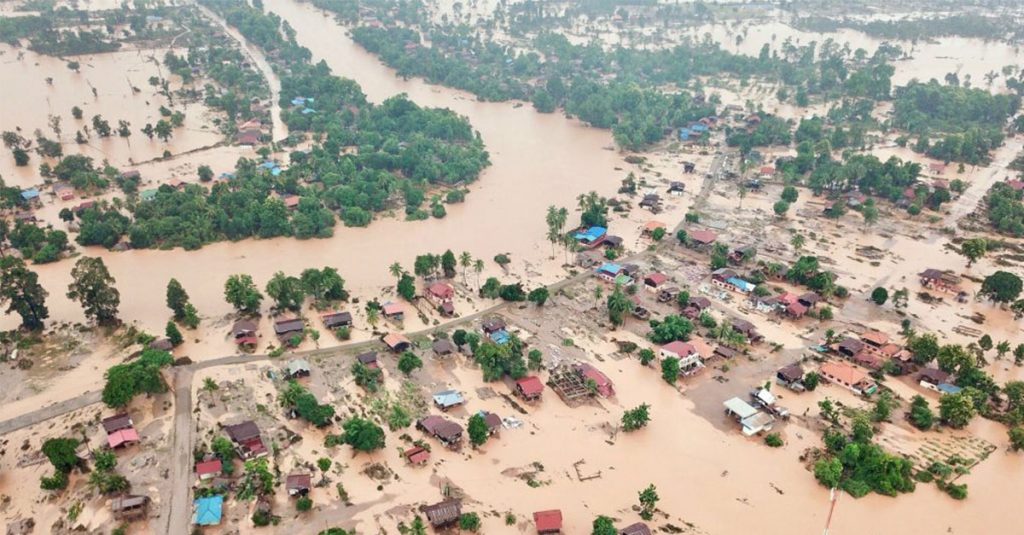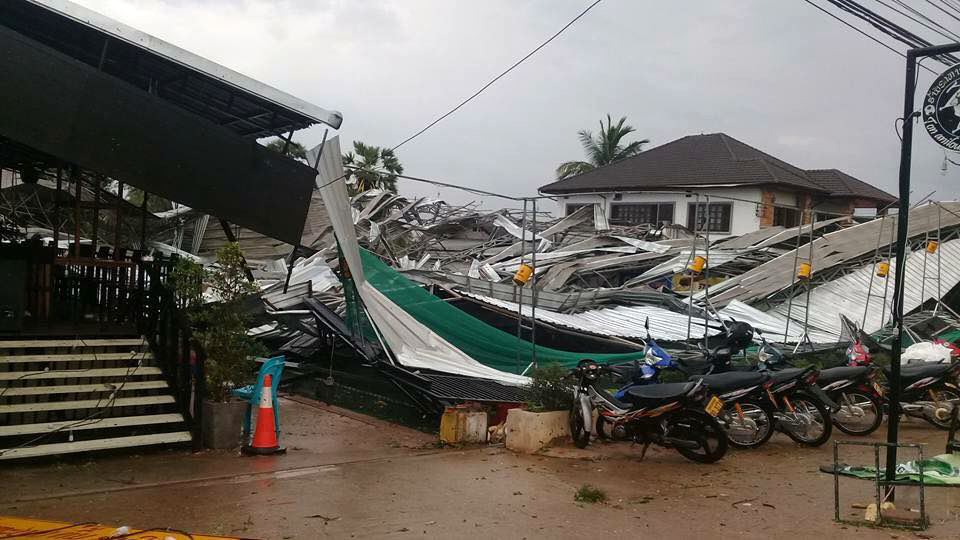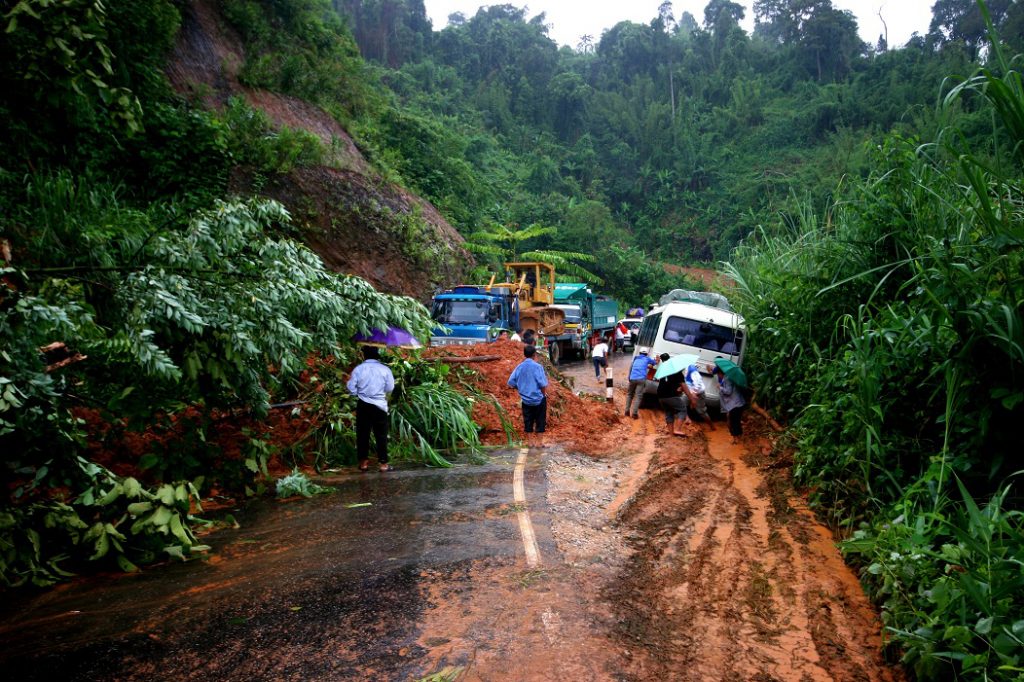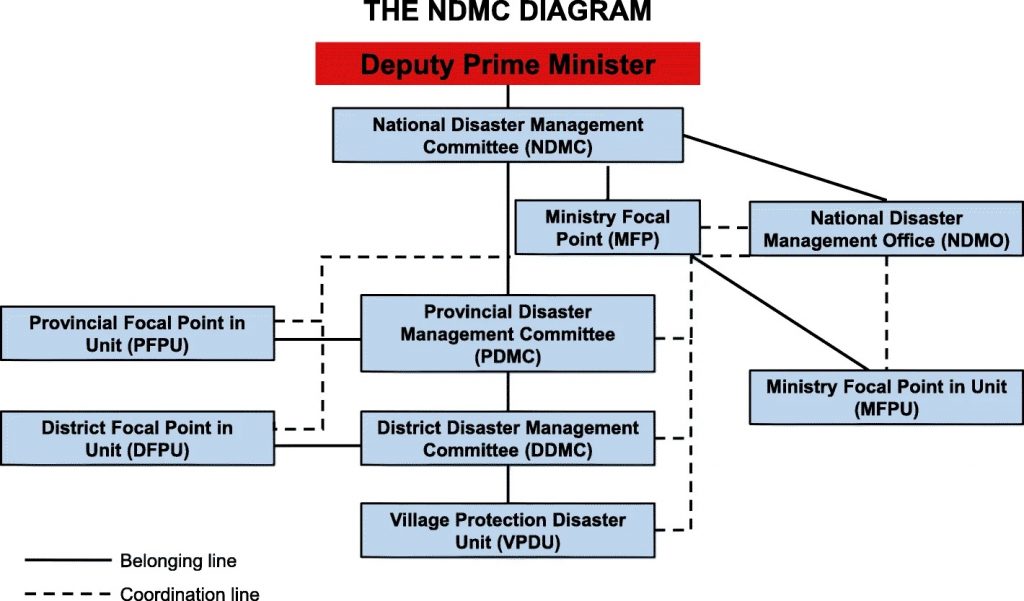The Lao People’s Democratic Republic (Lao PDR), shortly known as Laos, is a small, least developed country in Southeast Asia, landlocked with Vietnam in the east, Thailand in the west, China in the north, Myanmar in the northwest, and Cambodia in the south, with total area of 236,800 km2 and about 7 million populations (2019). Laos is vulnerable to several types of disasters. Floods and landslides are prevalent, while droughts also occur in some years in different regions. Additionally, pests and disease are likely surging under the changing climate and environment.1
Floods and Storms
Floods commonly occur during the wet season from May to October, and more specifically during August and September when tropical storms, cyclones, and typhoons normally batter. Floods occur regularly in the lower floodplains along the Mekong river and its tributaries, mostly in the central and southern provinces. Meanwhile, other downstream areas throughout the country are also affected. Savannakhet, Khammuane, Champasak and Attapeu are the most likely affected provinces. In 2008, torrential rains caused flooding around the Mekong River, affecting 228,320 people and killing dozens with the estimated loss over US$4 million. In 2011, Laos was hit by a string of tropical storms affecting 12 of its 17 provinces. An estimated half a million people were affected by this flooding.2 Flooding in 2019 (as of 14 October), at least 765,000 people have been affected and 19 killed by Tropical Storm Podul and Tropical Depression Kajiki in Laos. As many as 97 bridges, 747 schools, 43 health centres and hospitals, 462 road places, 275,114 livestocks and poultry were affected by the floods. Total damage is estimated to cost US$164 million (1.45 trillion Kip).3

Arial view of Attapeu province partially submerged due to Dam collapse in 2018. Photo credit: Allan Liu (Hope Vision)
Flash floods occur during southwest monsoons, especially in northern and central parts and also some mountainous areas in the southern part of Laos. The effects are brief, localized and destructive. These events have tended to happen more frequently recently due to deforestation in mountainous areas.4 In July 2018, the collapse of saddle dam D at the Xe-Pian Xe-Namnoy hydropower project in southern Laos was caused by heavy rain from the Son-Tinh tropical storm and led to a massive flash flood, devastating thousands of farms, property and houses in Attapeu and Champasack provinces, and leading to 49 dead, 22 missing, and thousands homeless.5 In July 2019, a heavy rainstorm led to flash floods in eight villages of Nan district, Luang Prabang province; at least 372 families were affected with estimated damages of over 11 billion kip (approximately US$1.2 million).6 7
Besides torrential rain, storms bring strong wind, lightning and hailstones, especially at the start of rainy season, damaging houses, electric infrastructure, trees and livestock. In 2018, lightning strikes killed 27 cows in Kenethao District of Xayabouly Province, and 1 person in Nonghet District of Xiengkhuang Province. At the same time, local storms in northern and central parts of Lao PDR caused strong wind damage to many houses, trees and electricity poles. In Xiengkhuang, Oudomxay and Vientiane provinces, there were severe hail storms destroying house roofs and agricultural products.8

In Vientiane’s Hadxaifong district, several restaurants, factories and other buildings were left without roofs. Source: https://jclao.com/weekend-storms-batter-parts-laos/
Landslides
A large volume of groundwater after prolonged days of high precipitation causes landslides and slope failures. Roughly 5% of the country in the central and southeastern parts are affected by landslides, due to topography and soil conditions. In some cases, landslides are related to riverbank erosion. Most landslides result in partial or complete impasses to segments of roads, leading to economic losses, delays to traffic, and restricted movement of transport, and further require debris removal, repairs to retaining walls, roadside drains, and the resurfacing of roads.9 A landslide in Houaphan province on August, 3rd 2019 swept two houses into a river near the Laos-Vietnam border, causing seven missing, and motorists were warned about landslides at northern mountainous routes between Kasy district (Vientiane) and Nan district (Luang Prabang).10

People pushing a bus at a landslide site in Laos. Source: http://www.drivenachodrive.com/2013/09/a-landslide-brought-it-down/
Drought
Laos is vulnerable to droughts, which can occur throughout the country. Most drought events occur in western Champasak, Salavan and Savannakhet, and in the northeastern part of the country in Xiengkhouang, Houaphan and Luang Prabang provinces. When precipitation is low (less than 2.0 mm), drought conditions are worsened, and highly sensitive areas will be adversely affected. Laos is deeply impacted by extended drought conditions. Droughts have devastating effects on economy, causing agricultural failures, impacting food security and access to clean water. Laos experienced two considerable droughts in 2003 and 2007. In 2003, extreme drought conditions in the northern and central regions resulted in US$ 16.5 million in damages. The 2007 drought in the central region of Laos cost approximately US$ 1 million in damages.11 Recently in 2019, dryer climate conditions have also led to prolonged drought, with an alarmingly low water level on the main river, raising concerns to millions of lives relying on the ecosystems. In mid-2019, the Mekong river in Vientiane dropped to 0.7 meters below its average water level from 1961-2018, and rocks and sand underwater have been observed at many points. Nationwide, only 40 percent of rice fields have been transplanted due to the delay of rain.12

Women and children sit on the bank of the drought-hit Mekong River near the Lao capital Vientiane. Source: https://www.rfa.org/english/commentaries/mekong-threats-09132019155403.html
Pest and disease
Outbreak of pest and diseases in crops, animals and humans has threatened agricultural production and livelihoods of the country as well as people’s health. Since 2014, Laos has experienced a continuing outbreak of locust swarms in the northern provinces affecting many thousand hectares of crops (corn, job’s tear, cassava, rice, etc.) every year.13 14 15 The infestation of fall armyworms (Spodoptera frugiperda) on sweetcorn in Xayaboury province in 2019 destroyed 30 percent of 35,000 hectares of maize, causing huge losses to the farmers.16 As of November 2019, Laos has seen 165 outbreaks of African Swine Fever (ASF) in all provinces/cities, killing over 39,000 pigs in total.17

Yellow-spined bamboo locust outbreak in northern provinces of Laos in 2016. Source: https://www.asean-agrifood.org/lao-to-get-supports-from-thailand-to-halt-the-bamboo-locust-outbreak/
Dengue is an endemic in Laos, occurring throughout the country year-round. The outbreaks commonly rise during the wet season, from May to October.18 In 2013, Laos experienced the worst dengue epidemic, with 44,171 cases and 95 deaths reported.19 In 2017, there were 11,067 dengue cases and 14 deaths,20 while 6,446 cases and 19 deaths were recorded in 2018 21 As of July 2019, dengue claimed 37 lives, with at least 16,690 cases in the country.22 Other than dengue fever, the most common diseases in Laos include influenza, heart disease, and diarrhea, most of which are due to poor sanitation and inefficient accessible healthcare.23
Other Threats
Unexploded ordinances (UXOs) are also considered one of the hazards threatening the livelihoods of people and food security in Laos. UXO accidents, though decreasing, still happen every year, with death and injuries. This hazard will not be detailed here; more information on UXO in Laos is available here.24
Laos is also at risk of earthquakes; over 30% of the country is located in a moderate earthquake hazard zone, though there is no record of relevant devastating disasters in the past.25 In 2015, Laos experienced a 5.0 magnitude earthquake, shaking the area between Borikhamxay and Xiengkhuang provinces; however, no damages were reported.26
Disaster preparedness and emergency response policy and administration
Having faced several disastrous hazards and natural events, Laos has prioritized and implemented disaster risk management (DRM) actions, in line with Sendai Framework for Disaster Risk Reduction (SFDRR), as follows:27
- Understanding Disaster Risk: Laos has developed risk profiles of hazards and their impacts at national and provincial levels, which allows the assessment of exposure and vulnerability of areas to enable effective emergency and response plans and strategies. Laos also established the DesInventar database system for collecting and analyzing disaster data, but it has not been up-to-date due to limitations in techniques, facilities and human resources. However, Laos recognizes the importance of information for planners and decision-makers to effectively and efficiently address disasters and their impacts.28
- Strengthening Disaster Risk Governance to Manage Disaster Risk: In the past, Laos mainly focused on emergency relief for victims of natural disasters, but not emphasized prevention and mitigation. It was not until 1999 that Laos had the national institutions to mandate disaster risk reduction and emergency response management. The National Disaster Management Committee (NDMC), led by the Deputy Prime Minister, was formed, which includes directors from various ministries. The NDMC has roles and responsibilities in coordinating early warning, preparedness, emergency response, and recovery activities. Functioning under the Ministry of Labour and Social Welfare, the National Disaster Management Office (NDMO) is the Secretariat to the NDMC, with further focal point structures at provincial and district levels. The committees and offices with formal lines of responsibilities have been established through the Provincial Disaster Management Committees, District Disaster Management Committees, and Village Disaster Management Committees. From 2013-2018, DRM functions were transferred to the Ministry of Natural Resources and Environment (MoNRE), while the Ministry of Labor and Social Welfare (MLSW) was accountable solely for disaster response and relief. However, at national level, DRM has been recently reassigned to Ministry of Labour and Social Welfare (MLSW).29

National Disaster Management Committee Diagram of Lao PDR. Source: Implementation of disaster risk reduction and management policies in a school setting in Lao PDR: a case study
In addition, Laos issued the National Strategic Plan for Disaster Risk Management 2003–2020 in 2003 and the National Disaster Management Plan 2012–2015 in 2011, which provided the current policy framework for disaster management in the country. The plans aim to reduce disaster risk to communities and to strengthen capacities for disaster management at the national, local, and community levels.30
- Investing in Disaster Risk Reduction for Resilience. From 2012-2016, Lao Ministries, namely the Ministry of Planning and Investment, Ministry of Public Works and Transport, and Ministry of Agriculture and Forestry started considering climate change and disaster risk resilience in the process of planning and investment for irrigation and road infrastructure. Since 2017, Laos has integrated climate change and disaster risk into considerations for public investment and decision-making. In addition, investments in resilience have also been incorporated into official development assistance projects under several donors such as the ADB, World Bank, and UN agencies, including in resilient road infrastructure, resilient urban planning, financial planning for disaster resilience, etc.31
- Enhancing disaster preparedness for effective response to “Build Back Better” in recovery, rehabilitation and reconstruction. Recurrence of disastrous events like floods and landslides has necessitated an effective early warning system in Laos. In 2010, the country discussed developing and establishing an early warning and information dissemination system in all 142 districts. A consultation for drafting a National Early Warning Strategy started in 2012, aiming to bridge information gaps between responsible agencies and communities. In 2017, Early Warning Standard Operating Procedures (SOPs) were developed to provide a concise list of major tasks to be executed by concerned agencies responsible for early warning. Warning alerts through mobile messages is also a complementary option to connect with a large group of subscribers quickly, under the cooperation with leading telecommunication operators such as Lao Telecom, UNITEL, ETL, and Beeline.32

Flood recovery in Lao PDR. Source: http://annx.asianews.network/content/lao-govt-decides-measures-address-flood-impact-104378
In terms of emergency response, the system was in early stages of development when the country was severely hit by the extensive flooding in 2008. In response to the incident, a multi-agency mechanism was formed in early August and started performing response operations and coordination, resulting in an effective response in Vientiane.33
To build back better, Post-Disaster Needs Assessments (PDNA) have been regularly conducted to identify most urgent needs and development priorities, jointly with other stakeholders. Also, methodologies to estimate sectoral damage and losses, as well as corresponding needs, have been developed and adapted to local requirements for Lao PDR since 2012. This involved developing standard operating procedures for PDNA, designing templates for sectoral data collection, forming provincial PDNA teams and providing capacity building.34
International assistance
Laos has worked with regional and international stakeholders in terms of disaster risk management, from preparation, response and recovery. Working with local government line agencies, international stakeholders like the UN, the World Bank, Save the Children, ADPC, Oxfam, French Red Cross, the Australian government, ADB, Care International, AHA Centre, and more have played important roles in providing local technical support, risk assessment and management, adaptation, vulnerability reduction, and resilient infrastructure development. International governments have supported relief and recovery following certain disaster events. Laos has also worked closely with neighboring countries on transboundary risk management, emergency response, weather forecasting and early warning to strengthen its DRM systems.35
References
- 1. Center for Excellence in Disaster management & Humanitarian Assistance. “Lao PDR Disaster Management Reference Handbook 2017.” (2017). Accessed October 2019.
- 2. Center for Excellence in Disaster management & Humanitarian Assistance. “Lao PDR Disaster Management Reference Handbook 2014.” (2014). Accessed October 2019.
- 3. AHA Center. “Lao PDR: Floods – Aug 2019.” (2019). Accessed November 2019.
- 4. Ibid.
- 5. Vaenkeo,
- 6. KPL. “Floods Cause Over 11 Billion Kip In Damages For Luang Pranang’s Nan.” Lao News Agency, Aug 1, 2019. Accessed October 2019.
- 7. Phonevilay, Latsamy. “Luang Prabang Villagers Hit by Flash Floods.” The Laotian Times, July 31, 2019. Accessed October 2019.
- 8. ESCAP/WMO Typhoon Committee. “Member Report Lao PDR.” (2018). Accessed October 2019.
- 9. ADPC. “Developing a National Risk Profile of Lao PDR.” (2010). Accessed October 2019.
- 10. Laoin, Phomphong. “Seven missing after Huaphan landslide.” Vientiane Times/ANN, Aug 6, 2019. Accessed October 2019.
- 11. Center for Excellence in Disaster management & Humanitarian Assistance. “Lao PDR Disaster Management Reference Handbook 2017.” (2017). Accessed October 2019.
- 12. Taejun Kang. “Laos Hit by Worst Drought in Decades.” The Laotian Times, Jul 25, 2019. Accessed October 2019.
- 13. Center for Excellence in Disaster management & Humanitarian Assistance. “Lao PDR Disaster Management Reference Handbook 2017.” (2017). Accessed October 2019.
- 14. News Desk. “Northern Lao provinces fighting locust invasion.” Vientiane Times/ANN, May 17, 2018. Accessed October 2019.
- 15. Jasmina Yap. “Locusts Swarm Northern Laos Wreaking Havoc on Crops.” The Laotian Times, May 5, 2017. Accessed October 2019.
- 16. News Desk. “Sweetcorn farmers suffer huge losses in Xayaboury.” Vientiane Times, July 25, 2019. Accessed October 2019.
- 17. FAO. “ASF situation in Asia update 2019.” (2019). Accessed November 2019.
- 18. IAMAT. “Laos General Heath Risks.” (2019). Accessed October 2019.
- 19. WHO in Lao PDR. “Dengue epidemic in the Lao People’s Democratic Republic.” (2014). Accessed October 2019.
- 20. National Center for Laboratory and Epidemiology. “Dengue Outbreak.” (2018). Accessed October 2019.
- 21. Xuxin. “Severe form of dengue continue to mount in Laos.” Xinhua, July 18, 2019. Accessed October 2019.
- 22. Pongkhao, Somsack. “Laos takes steps to tackle six urgent issues.” Vientiane Times/ANN, Jul 26, 2019. Accessed October 2019.
- 23. Sarah Denning. “4 Common Diseases in Laos.” (2017). Accessed October 2019.
- 24. ADPC. “Developing a National Risk Profile of Lao PDR.” (2010). Accessed October 2019.
- 25. Ibid.
- 26. J&C Admin. “5.0 Earthquake Shakes Landlocked Laos.” J&C Services, May 29, 2015. Accessed October 2019.
- 27. ADPC & UNDRR. “Disaster Risk Reduction in Lao PDR: Status Report 2019.” Bangkok, Thailand, United Nations Office for Disaster Risk Reduction (UNDRR), Regional Office for Asia and the Pacific. (2019). Accessed October 2019.
- 28. Ibid.
- 29. Kanyasan Kethsana, Daisuke Nonaka, Athithouthay Chatouphonexay, Paul Michael Hernandez, Sengchanh Kounnavong, and Jun Kobayashi. “Implementation of disaster risk reduction and management policies in a school setting in Lao PDR: a case study.” Tropical medicine and health 46, no. 1 (2018): 42. Accessed October 2019.
- 30. ADPC & UNDRR. “Disaster Risk Reduction in Lao PDR: Status Report 2019.” Bangkok, Thailand, United Nations Office for Disaster Risk Reduction (UNDRR), Regional Office for Asia and the Pacific. (2019). Accessed October 2019.
- 31. Ibid.
- 32. Ibid.
- 33. Ibid.
- 34. Ibid.
- 35. Ibid.

